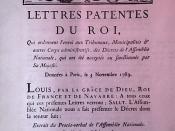The French Revolution
Section 1:The Old Order
- At the time when the Americans were gaining independence from Great Britain, the French monarchy was at it's height.
- All French people belonged to one of three estates, or orders of society
- These estates determined the legal rights and status of the person.
- The First Estate was formed by the Catholic Clergy. The Second Estate was formed by the nobility. Everyone else formed the Third Estate.
- The people of the First Estate were entitled to many things. One of these things was the tithe. The tithe was a ten percent tax income from each church member.
- However one 'deconstructs' their undoubtedly scholarly work on ideological grounds, these publications did help to shift the debate on 'artisans and sansculottes' away from what had become rather sterile arguments about how many sans-culottes could dance on the tip of a marxist pin to wider concerns about the value of community, work processes and relationships, as well as the impact of philosophical and political ideas on late eighteenth-century French society.
- 'Culture' was rapidly replacing 'class' as the buzz-word of a new generation of researchers.
- This new interest in intellectual and cultural history enabled many good historians of the Revolution to pour new conceptual wine into old 'class' bottles.
- Another corrective to ideologically-charged and structuralist accounts of 'the People' can be found in Richard Cobb's highly original and readable,
- The Police and the People. Although influenced in his earlier years by marxist scholars, Cobb was, in reality, an English, Oxbridge anarchist/individualist, endowed with a profound knowledge of French archives and French bars, who liked to tell it as it was, rather than how it should have been in the book according to Marx, Weber, or, indeed, anyone else!...



Good
Im not a huge fan of the semi point form, But I like how you've grouped hte ideas together
1 out of 1 people found this comment useful.